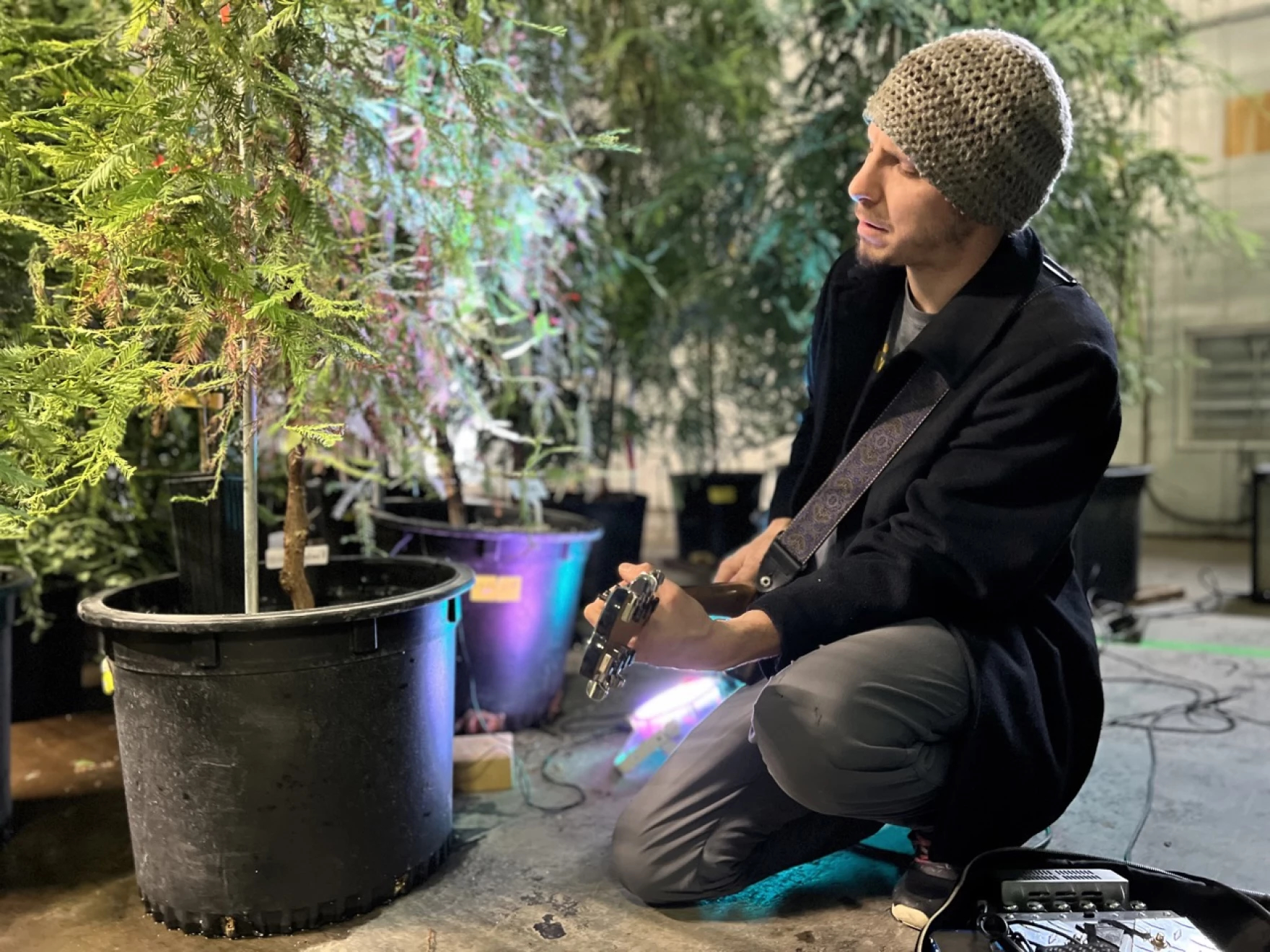The following transcript is from an episode of Points North, a narrative podcast about the land, water, and inhabitants of the Great Lakes. Listen to more episodes at pointsnorthpodcast.org.
DAN WANSCHURA, HOST: This is Points North, a podcast about the land, water and inhabitants of the Great Lakes. I’m Dan Wanschura.
(musical notes)
These piano notes aren’t coming from any musician – at least not any human one. This is the music of a sequoia tree sapling.
(musical notes with guitar accompaniment)
The guitar chords, on the other hand, are played by the tree’s band mate: Tom Wall, a guy from west Michigan. He’s sitting on his knees with his eyes closed – just feeling the energy of the plant life around him.
(music)
The tree makes the piano melody from a plant music machine. Supposedly, devices like these are able to harness the electricity in plants. And then turn those impulses into musical notes. Sounds straight out of science fiction, right? Not for Tom. He says the device makes him think deeply about what plants can do.
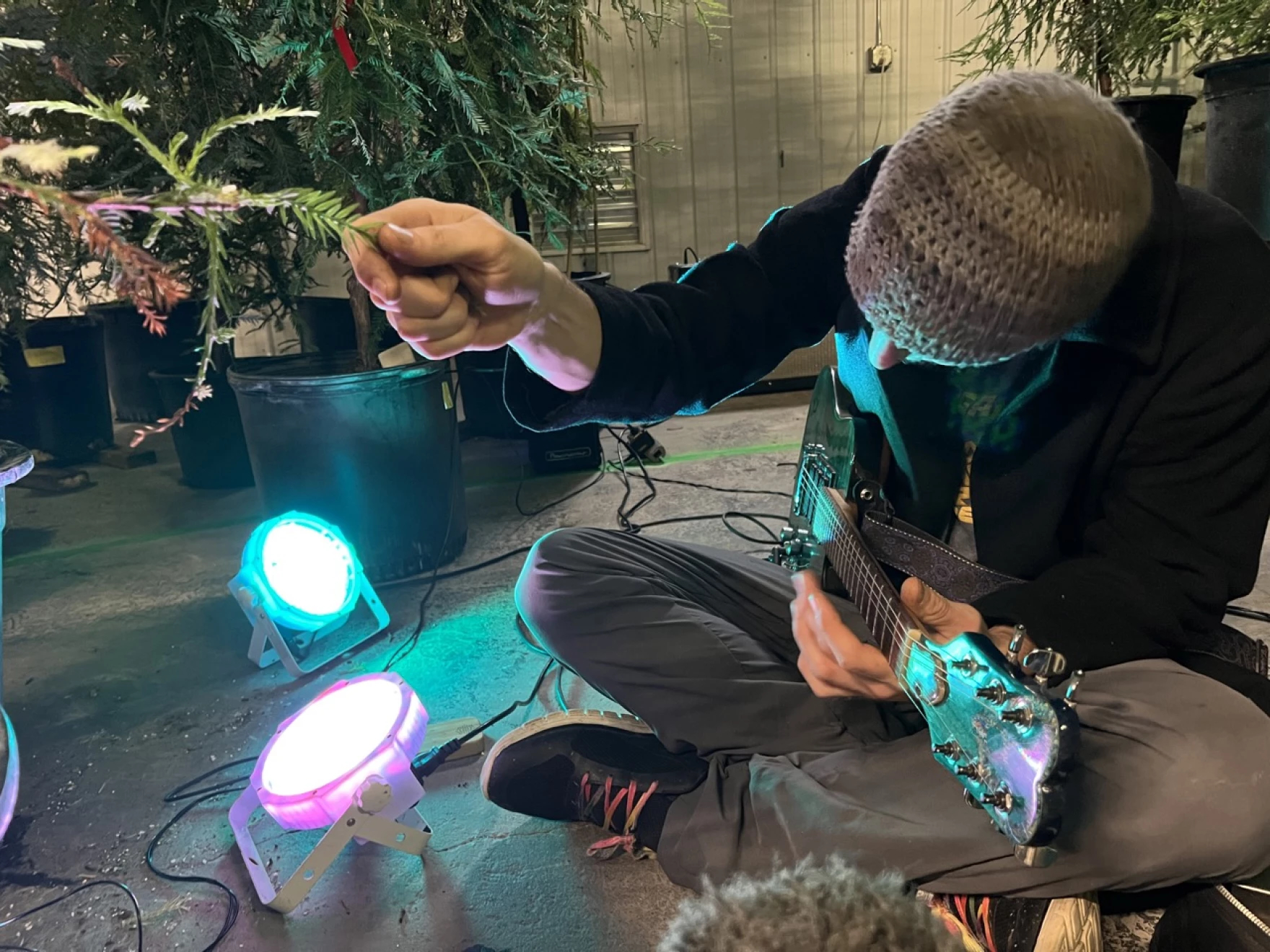
TOM WALL: Much like you talk to a person that doesn’t know your language, right? You can still understand the basic reactions like the excitement of somebody or the melancholy or the down-ness. If it’s playing real low bass notes, just really not happy. You can hear it’s not happy. But, if it goes really happy and you’re really excited, and it’s playing really fast. Well, that means it’s just like a human and it’s expressing emotion.
WANSCHURA: Tom thinks the plants are talking to us through the music. But are plants really capable of that? We’re going to explore that in today’s episode, The Plant Musician. Reporter Michael Livingston goes down that rabbit hole, right after this.
(sponsor message)
MICHAEL LIVINGSTON, BYLINE: Tom Wall and I meet up in a small town in northern Michigan called Copemish.
LIVINGSTON: It’s awesome to be here and good to meet you finally.
WALL: Absolutely man, I’m glad it worked out.
LIVINGSTON: We’re at a place called the Archangel Ancient Tree Archive. It’s essentially a tree library. It’s filled with saplings propagated from some of the world’s most ancient trees.
WALL: Then there’s a bunch of willows. They’re black willows from the champion black willow trees.
LIVINGSTON: Tom looks like a rock star. He’s tall with a patchy beard, wearing a long, black trench coat and what looks like a hand-knit beanie. He smells like weed and essential oils.
WALL: So, we have a little cubby hole that’s not wet back here, so this is what we’re going to run into, okay?
LIVINGSTON: He already has his rig set up between rows of baby sequoias. He has a Fender amp and about a dozen guitar pedals. He even made his own guitar from scratch out of stone and wood he found in Michigan.
WALL: Yeah, yeah. It’s got the mojo for sure. It’s got a very interesting iridescent quality like a peacock, almost, feather in the sunlight when you can see it right. It’s the best way I can describe it.
(music)
LIVINGSTON: Tom is a professional musician. This song is by Tom’s psychedelic rock band – Cosmic Knot.
(music)
It’s a single from their album Inner Space. It got a lot of love in jam-band circles and even made some charts. But things fell apart around the pandemic. That’s when Tom decided to order the plant music machine.
WALL: It’s just this little device. It’s about the size of your cell phone. But you can access 128 different noises on it. So, like a piano or percussion – it’s like a keyboard – they have those different patches you can put in there.
LIVINGSTON: So, you are giving the plants the instruments to use?
WALL: Yes, and so if we attach the one to the root, the one to the leaf and then we turn it on – and it will start playing music.
LIVINGSTON: The device comes from the Italian company Music of the Plants. It cost around 400 bucks. As plants grow, electricity is moving through them, just like any living thing. When the probes are attached to the roots and leaves, the company claims it’s capturing those electric impulses. Tom has some creative control but he can’t actually force the trees to play. He says they need to make that decision.
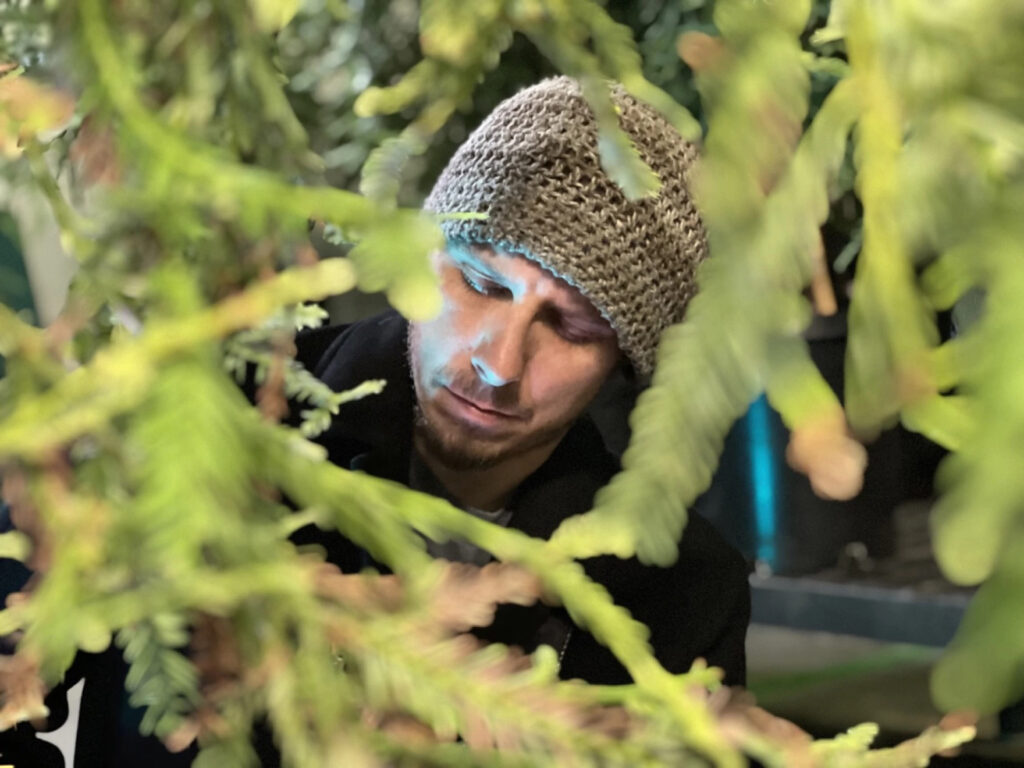
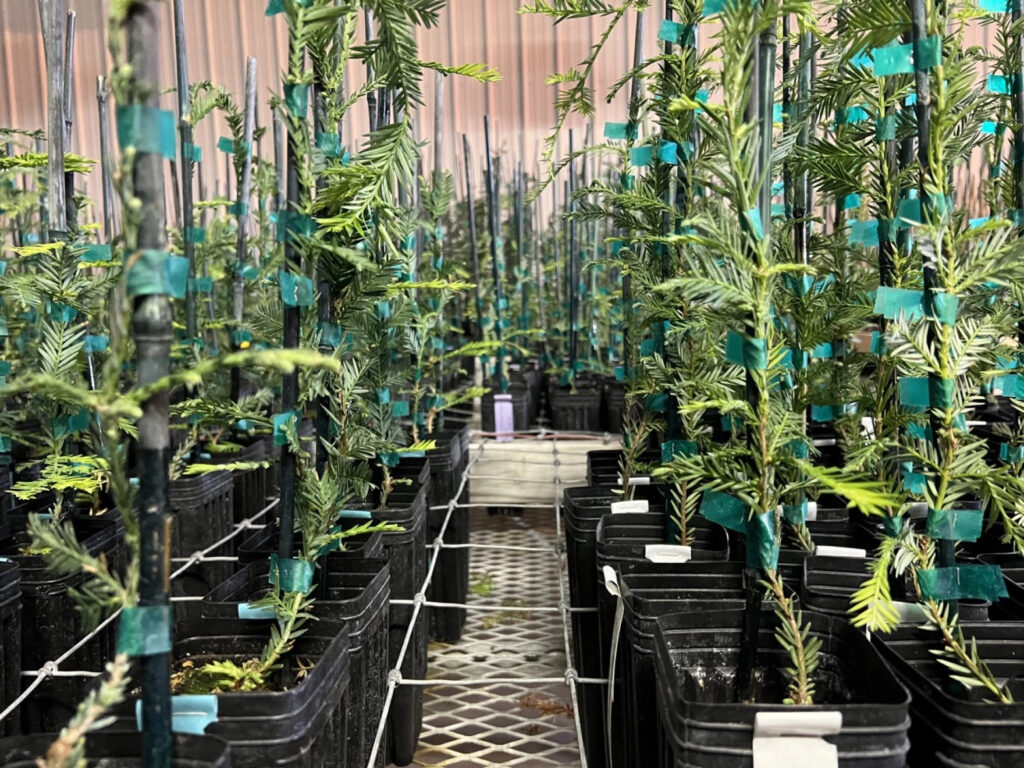
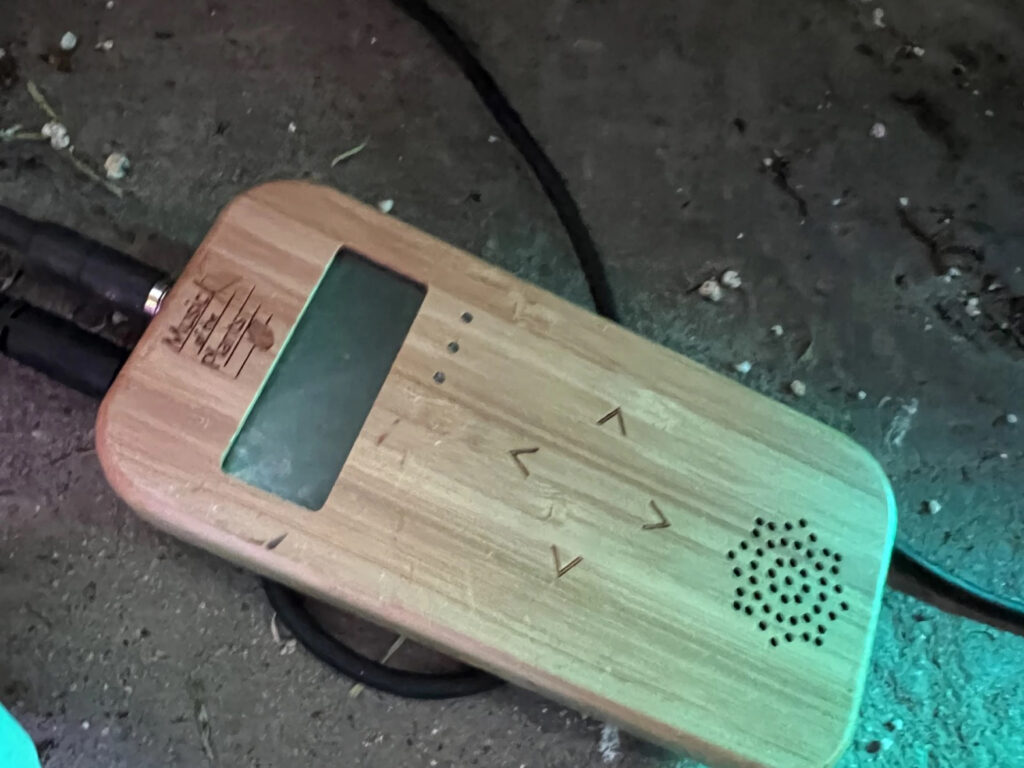
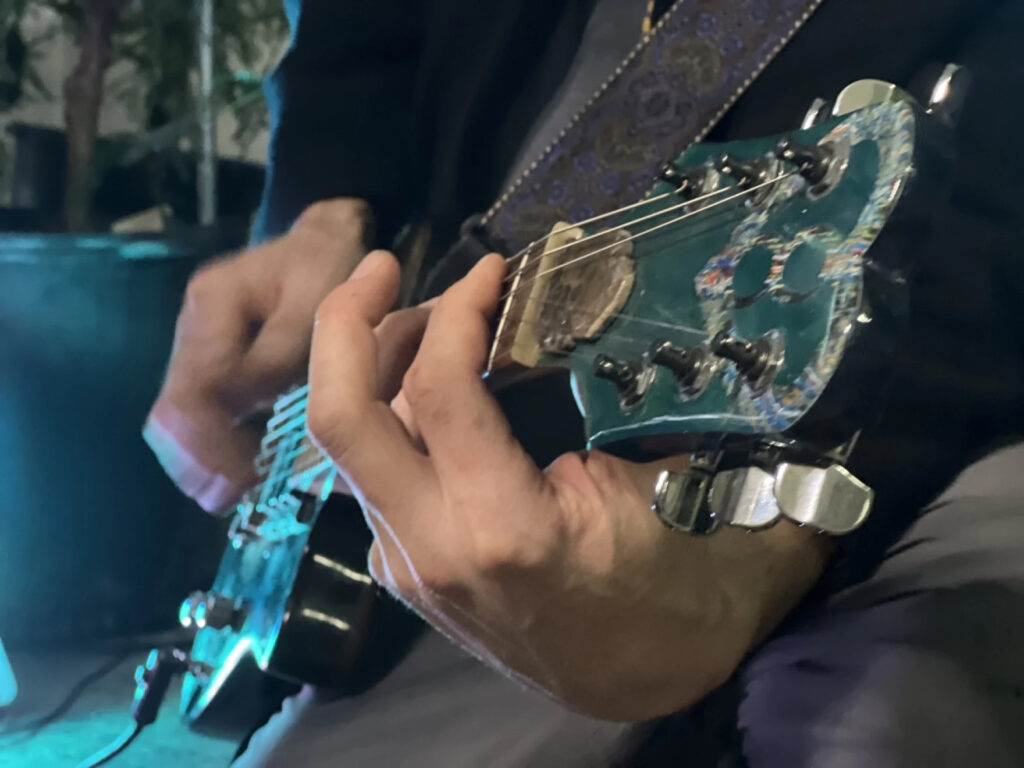
WALL: It really just depends on the day and the time with the trees and the plants. Sometimes they play amazingly well, sometimes they don’t want to play at all… these trees really do respond to what’s going on. And I can’t stress that enough. Like they’re really picking up on some vibrations that are going on around here.
LIVINGSTON: So, what are you expecting? Today, we’ve had some rain, it’s kind of cloudy outside, we’re inside right now, is any of that going to affect how this sounds?
WALL: I think that, just like a person, it really depends on the moment and how they’re really feeling. I think it’s going to be a little laid back today. Doesn’t seem like it’s gonna be one of those days where it’s so overexcited, that it’s hard to listen to you because sometimes it plays so many notes. You’re just like, “Wow!” It’s like listening to hyper jazz or something, you know, and you’re like, “Ah, that’s a bit too much for me.”
LIVINGSTON: Now, Tom begins his demonstration.
WALL: Alright, y’all ready for this?
LIVNGSTON: Yeah!
LIVINGSTON: He hits a button on the small box, then a few notes fall out of the speaker.
(notes play)
But then silence – almost as if it’s shy to play for a stranger. That’s when Tom reaches out a hand and holds a branch in his palm.
(notes fire off)
LIVINGSTON: It seems to like you!
WALL: Right, we’ve got a relationship cause we’ve been playing music together before. But with you it might not know and it spooks them a little but so … you just never know how they’re going to respond.
(more plant music)
LIVINGSTON: I’ll admit, in that moment it really did feel like the sequoia tree showed real emotion. When Tom held its branch, it seemed to feel more comfortable – like a parent holding their child’s hand.
WALL: That’s the whole point, is just to show us that we are nature itself and those trees are no different than us and we’re all one. So, we got to take care of it.
LIVINGSTON: Tom thinks the tree tried to speak to him in that moment. Or at least felt his energy in some way. I don’t know. I still have questions. How much of what we’re hearing is actually coming from the plants, or the device, or Tom? After all, he can pick the instrument and set the key the plant plays in – both are super important to conveying any sort of emotion in the music. Tom will be the first to say he’s an artist, not a scientist. Even still, are the plants actually communicating through the song?
Frank Telewski is a plant biology professor and former director of Michigan State University’s Botanical Gardens and Arboretum. His colleagues know him by another name.
LIVINGSTON: You have gotten the nickname, the Lorax, what’s the story behind that?
FRANK TELEWSKI: You’ve done your homework! Basically, I love trees. I mean, I’ve always loved trees, as long as I remember, as a kid growing up in Fort Lee, New Jersey … And I’ve actually been able to save a lot of trees from removal on campus during construction. And so that’s sort of gotten me the name The Lorax.
LIVINGSTON: Frank has heard plant music before, and true to his nickname, he believes there is more to plants than we understand. I played him a bit of Tom’s music with the sequoia.
(sequoia plant music)
TELEWSKI: Well, I think there’s a lot to be learned from it. I think, just to step back and think about the piece of music that you played, I mean, it’s from an aesthetic perspective, just taking advantage of those signals that we may not understand, and not be able to interpret yet, and create something of beauty out of it – is kind of a neat, unique human thing I think to do.
LIVINGSTON: On the microscopic level, Frank says Tom’s machine is more like a heart monitor.
TELEWSKI: Beep, beep, beep, beep – that’s the heart monitor … programmed to generate a tone, every time the electrical impulse triggers the heartbeat.
LIVINGSTON: A steady rhythm conveys we’re healthy or at least stable. Electricity flows through all living beings. Those impulses are what help us do literally anything in our bodies. In humans, electricity moves around in our nerve cells. But in plants, it flows freely through the cell wall.
TELEWSKI: It’s how living organisms can communicate within a multicellular body, a multicellular organism.
LIVINGSTON: That free movement is what makes the unpredictable rhythm of plant music, instead of the steady beat of the heart monitor. So yes, in a way, the music is coming from the plants. But even the Lorax would admit, saying plants are sentient – meaning they know what messages they’re communicating with the music – that’s a huge stretch.
TELEWSKI: It would be hard to have creativity without some level of sentience and to have a sentient plant, beyond the science fiction of Groot… Is it impossible? I won’t say it’s impossible. Is it a long, long way away? Or is it someplace on another planet in the galaxy far, far away? Maybe.
LIVINGSTON: Other researchers, like Mia Howard, are less optimistic. She studies ecology and evolutionary biology at University of Michigan. I played her a bit of plant music too. But unlike Frank, this was her first time hearing anything like this.
(sequoia plant music)
FRANK TELEWSKI“It would be hard to have creativity without some level of sentience and to have a sentient plant, beyond the science fiction of Groot… Is it impossible? I won’t say it’s impossible. Is it a long, long way away? Or is it someplace on another planet in the galaxy far, far away? Maybe.”
MIA HOWARD: I don’t know. I’ve never heard a plant make noises like that before.
LIVINGSTON: Mia’s research focuses on how plants defend themselves from predators in their ecosystems. She says there are risks that come with personifying plants too much. And that can happen a lot, skewing scientific findings.
HOWARD: There’s definitely information there that we could take something from. But I don’t think we were the intended audience for these signals … But I think these plants are probably just living and just having their water move through them and responding to stresses and not necessarily making music for the reasons that humans make music.
LIVINGSTON: But Mia says plants do communicate. Just not in ways we can hear. Plants send out chemical signals that are noticed by other species. They can protect themselves with these signals or even warn others of danger.
HOWARD: Their metabolism changes a lot when they’re under stress. And a lot of times these chemicals in their metabolism can get released into the air.
LIVINGSTON: It’s exciting to think about plants speaking in secret languages – chemical or electronic.
HOWARD: I think it’s good to talk to your plants.
LIVINGSTON: Do you talk to your plants?
HOWARD: Yeah, sometimes. And I think, yeah, it’s a good thing to talk to your plant, they might not hear you. But if anything, you’re adding more carbon dioxide to their environment. And they like that.
LIVINGSTON: But, it’s important to remember plants are very different from us.
HOWARD: I think there’s a danger in reading too much into it. And thinking that these plants are trying to communicate with us when these plants might just be expressing their physiological state.
LIVINGSTON: So, back to the big question, can we speak with plants through music? These scientists say, probably not. Even if Tom’s device is detecting the sequoia’s vitals, the plant is likely unaware it’s creating a song. But does any of it really matter?
(plant music)
This machine has only made Tom more curious about the natural world and he wants others to be curious too.
(musical notes with guitar accompaniment)
Thousands of people have watched videos of Tom jamming with the plants on his Youtube channel. Like this video where he’s playing with cannabis plants.
(cannabis plant music)
WALL: Yeah, I expect people to think that’s a potential that it might be, oh my gosh, some far off fantasy. But I can assure you that based on my experience, going into it with that same notion that I’ve been proven so much that that’s not the case, that I’ve actually been pretty much shaken to my core. And I’ve had to re-change the whole entire way I look at life.
LIVINGSTON: Change to seeing plants more as living things rather than inanimate objects. And, he says, that came from the music.
That’s something our scientists are on board with: If plant music gives someone a new appreciation for the importance of plants – then that’s all that really matters.
